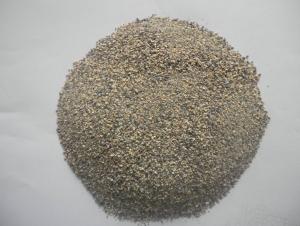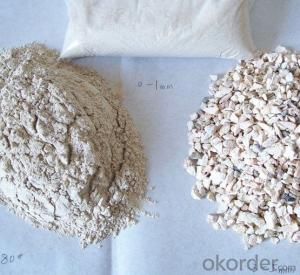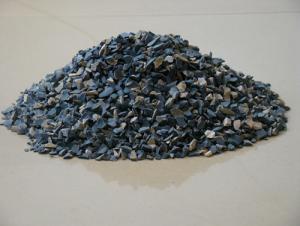Raw Materials for Refractory - Brown Fused Alumina Materials
- Loading Port:
- Tianjin
- Payment Terms:
- TT OR LC
- Min Order Qty:
- 20 m.t.
- Supply Capability:
- 1000 m.t./month
OKorder Service Pledge
OKorder Financial Service
You Might Also Like
Brown fused alumina is made from high quality bauxite by fusing in an electric arc furnace at high temperature. It has good toughness and high hardness. It can be used to make superior refractory products.
Specification
Application
Brown fused alumina is used as a raw material in the manufacture of high alumina refractories.
In the same condition, using manganese or silicon to deoxidize separately, the burn out rate are 46% and 37%, but it is only 29% if using manganese alloy to deoxidize. So, it is used widely to smelting steel and its output increases faster than ferroalloy's, so has become an indispensable composite deoxidizing and alloy additives in steel industry. The silicon-manganese which contains carbon below 1.9% still is used to produce medium/low-carbon ferromanganese and semi-finished products of electro silicothermic process manganese metal.
- Q: A chemical problem with refractory materials
- No, in junior high school may be exposed to AlN aluminum nitride, high temperature resistant new ceramic, water will react...
- Q: How much is refractory spraying coatings?
- This depends on whether you use the thin coatin or thick coating. Then it depends whether you use an aqueous coating or oily one. Usually thick aqueous coating is 2-3 dollars per kilogram. While the thin is six or seven dollars per kilogram. The oily coating is more than ten dollars. The prices obtained from the Internet is for reference only.
- Q: Who knows the model of fireproofing materials?
- Models of fireproofing material: PC 6555 Bayer 6555 fireproofing PC 6557 Bayer 6557 fireproofing PC 6485 Bayer 6485 fireproofing PC 6385 Bayer 6385 fireproofing PC 6265 Bayer 6265 fireproofing PC 2865 Bayer 2865 fireproofing PC 4610 Dow 4610. Hope my answer will be helpful to you!
- Q: Where is the distributing center of refractory materials in China?
- The construction of Gongyi Chinese refractory chemical industry professional market is a street in Yongan to implement the spirit of the six plenary session of the four session of the Gongyi municipal Party committee, the adjustment of economic structure, an important step in developing the service industry out of the. First, to promote the rapid development of the third industry. Through the improvement of refractory trade logistics system, make Yongan do truly become the first-class refractories trade and logistics center, driven by the refractory industry from the production area to the exhibition, logistics field extension and transformation, become refractory chemical industry center, Yongan office to promote the optimizing and upgrading of economy. Two is to promote intensive land development. Through the integration of resources, the unified planning of the reserved land, intensive development according to the standard of the city, the introduction of powerful investors, construction of large-scale projects. Three is to further create a business atmosphere in Yongan. Refractory chemical professional market operation, will promote the overall development of Yongan to do business, increase the flow of people, logistics, information flow, capital flow, more to promote the rapid development of the third industry in Yongan office.Gongyi Chinese refractory chemical industry professional market completion, will further promote the development of Yongan street service industry, accelerate the pace of economic restructuring, will run the streets of industrial upgrading has played a great role in promoting. Yongan road street is unprecedented high spirited gesture, innovation and development opportunities, so that industrial upgrading and optimization of the pattern to accelerate the realization of, we are convinced that Yongan's tomorrow will be better!
- Q: How long is the duration of fire resistance of hollow glass magnesium board
- Glass magnesium board is non-combustible board with excellent fire resistance ability, the continuous burning time of flame is 0, non-combustible at 800℃, no flame at 1200℃, achieving the highest level of fire retardant level A1; Partition System cooperated with high-quality keel can endure fire for more than 3 hours. In the process of combustion, a large amount of heat energy can be absorbed, and the temperature of the surrounding environment will be delayed.
- Q: How to divide the fire rating standards of insulation materials?
- 1. According to the GB8624-97 national standard, building materials can be divided into following levels in terms of combustion performance. A-level: Non-combustible building materials: Materials almost don't burn. B1-level: Fire-retardant building materials: Fire-retardant materials are good at resisting flame. It is difficult for them to burst into fire when coming across open fire in the air or at high temperature. It will not quickly get wilder and when the fire source removes, it will be extinguished immediately. B2-level: Combustible building materials: Combustible building materials can play a certain role in preventing combustion. It will immediately burst into flames when coming across open fire or at high temperature, and will lead to fire spreading, such as wooden pillars, roof frames and beams as well as stairs. B3-level: Inflammable building materials: Inflammable building materials are highly flammable with no flame retardant ability. The fire risk is high. 2.The exterior wall thermal insulation materials can be classified according to fire rating. 1. Insulation materials with A-level combustion performance: rock wool, glass wool, foam glass, ceramic foam, foam cement, close-celled perlite, etc. 2. The insulation materials with B1-level combustion performance: specially-treated extruded polystyrene boards(XPS)/ specially-treated Polyurethane(PU), Phenolics, Polystyrene rubber powdery particles,etc. 3. Insulation materials with B2-level combustion performance: Expanded polystyrene sheets(EPS), Extruded polystyrene board(XPS), Polyurethane(PU), Polyethylene(PE), etc.
- Q: What is the classification standard of fireproofing material levels?
- Standard: Class A: Incombustible building material, almost without burning. class A1: Non-combustible, no open flame,class A2: Non-combustible,it needs to measure smoke and be qualified. Class B1: Nonflammable building material: Nonflammable materials have good flame resistance function. when it contacts open fire or is under high temperature, it's difficult to burn and be spreading rapidly, and will stop burn after removing the combustion?source. Class B2: Combustible?building?materials: Combustible materials have good flame resistance function. when it contacts open fire or is put in the air at high temperature, it will immediately burst into flames, and easily result in the spreading of fire, such as wooden column, timber roof truss, timber beam, wooden stairs, etc. Class B3: Inflammability building materials, without any flame resisting effects, easy to burn, and has large danger of fire disaster.
- Q: Who knows about ranking rules of fireproofing thermal insulation materials for exterior wall?
- (1) the height of buildings is greater than or equal to 24 m, the combustion performance of thermal insulation material should be A-level. (2) the height of buildings is less than 24 m, the combustion performance of thermal insulation materials should be A- or B1-level. When using B1-level thermal insulation materials, fire barrier zone should be set in each floor. (3) incombustible materials should be used as the protective layer of thermal insulation materials. Thermal insulation materials should be completely covered by protective coatings. The thickness of protective layer should be no less than 3 mm. (4) The base walls should be set in buildings with nontransparent curtain wall structures of metal, stone,etc. The fire endurance of which should comply with relevant provisions of current fire?safety?rules on fire endurance of external wall. The fire endurance and fire protection construction of pier?between?two?windows, window sill walls, skirt walls of glass?curtain?walls should comply with relevant provisions of current fire?safety?rules on building curtain walls. (5) the internal cavity of base walls, as well as the space between the skirt wall and base walls, pier?between?two?windows, window sill walls should be sealed with fire-proof sealing materials at each floor.
- Q: what is the material of fixed first rate fire resistant window?
- Fixed first rate fire resistant window is produced by the steel sash windows, steel casement, fireproofing glass. Fireproof windows, is composed by steel window frame, steel casement, fire-proofing glass. it refers to the window which can isolate and stop the fire spreading. The fire window product is named after the main material of window frame and the window casement, window frames is made of steel, casement is made of wood or the sash frame is made of wood and the casement is made of fire window.
- Q: What are the additives and recipes of refractory?
- SM water reducing agent
Send your message to us
Raw Materials for Refractory - Brown Fused Alumina Materials
- Loading Port:
- Tianjin
- Payment Terms:
- TT OR LC
- Min Order Qty:
- 20 m.t.
- Supply Capability:
- 1000 m.t./month
OKorder Service Pledge
OKorder Financial Service
Similar products
Hot products
Hot Searches
Related keywords
























